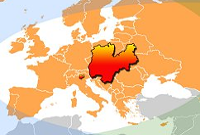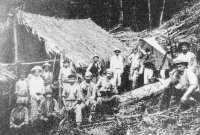

What it is, as well as what it isn’t

The special autonomy of Trentino (and of neighbouring Alto Adige-Südtirol, which together with Trentino comprises the Autonomous Region of Trentino Alto Adige) was born from an agreement between Italy and Austria, signed in Paris on 5 September 1946 by the then Italian Prime Minister and Foreign minister, Alcide Degasperi, and the Austrian Minister of Foreign Affairs, Karl Gruber. The text of the Statute went on to be approved by the Italian Constituent Assembly (in charge of drafting the Constitution of the post-fascist Republic of Italy) and subsequently became Constitutional Law No. 5, passed on 26 February 1948).
The people of Trentino and the Südtirol usually refer to this Statute as the First Statute of Autonomy, to distinguish it from the Second Statute, adopted in 1972.
But in reality the autonomy of a border province like Trentino cannot be born from one day to the next, and nor can it be the fruit of a legislative act alone (although, as we have seen, it is of a constitutional nature based on a peace agreement between two sovereign states, signed in the aftermath of two world wars). The origin of our autonomy goes back many centuries, and is made up of complex events, traditions, civic customs and rules which the communities have developed over time and jealously guarded throughout the course of their many political and social upheavals. And it is this that explains the attitude of the people of Trentino to the question of self-rule, to doing things their own way: it is not a case of selfish isolation, far from it – as a matter of fact, they have always maintained a dialogue with the world beyond their frontiers, from the remote border regions to the Government in Rome, and indeed to the European Union.

The linguistic minorities, mid-way between the Italian and Germanic worlds: a history going back many centuries of doing things their own way
The Statute of Autonomy of Trentino Alto Adige thus represents, first and foremost, an achievement by the people of Trentino and Alto Adige/Südtirol, united by numerous historical and cultural ties. The fact that they have become accustomed over the centuries to contact and comparison with other people – owing to the position of the region, astride the Brenner Pass, the main communications route between Italy and Germany – has meant that autonomy is founded on respect and appreciation of the value of the minorities, on the knowledge that the variety of cultures is an indispensable resource. Regarding Trentino, this means primarily protecting the Ladino minority (living in much of the Dolomite area) and the small German-speaking minorities (the Mocheni in the Fersina valley and the Cimbri on the Luserna plateau).
The second “pillar” on which the autonomy of Trentino rests is that of participation: autonomy belongs neither to politics nor to the provincial government, but to everyone, from the individual to the local communities, from economic sectors to associations, from church parishes to the world of culture, the universities and scientific research. Everyone is called on to contribute to managing this autonomy and sharing the responsibilities it brings with it. For us, autonomy therefore means doing things ourselves, as we are used to, rather than delegating to others the task of meeting the community’s needs across a whole range of areas: from schools to health, from economic development, social and health policy to the management of energy sources and urban planning, from the promotion of tourism to development cooperation and the management of a number of responsibilities and functions pertaining to the international side of politics. Seen in this light, autonomy becomes not only an efficient tool of self-government, but also a powerful didactic instrument which never ceases to bear fruit, not least as regards the new generations.

Autonomy at the service of cohabitation, peace and development
Autonomy conceived in these terms cannot fail to be a resource in the pursuit of cohabitation, peace and sustainable development safeguarding the equilibrium of the environment.
Thanks to autonomy, a region which was once poor and subject to outward emigration (there are Trentino communities in all five continents!) now consistently ranks among Europe’s top regions in terms of per capita wealth and, above all, quality of life.
But autonomy has also proved to be a school in solidarity; our experience has helped us to understand that if populations do not offer each other support in hard times, if they pursue their objectives in isolation, thinking only of their own interests, it will be much harder to cope in times of adversity, and their prosperity, no matter how stable it may seem on the face of it, will in fact be more fragile.
It is for this reason that Trentino always offers assistance to other regions and peoples going through difficult times (for example, through its civil defence service, or the hundreds of voluntary organisations operating inside as well as outside Trentino, primarily in the Third World). For the same reason, moreover, autonomous Trentino has always honoured its commitments to the Italian State, including those regarding economic trends and public finances (stability pact etc.). The autonomy of Trentino is therefore a school not of egoism, but of responsibility, starting from the management of resources, 9/10 of which come from taxes and duties produced by the area (according to the Milan Agreement in December 2009 the variable quota previously negotiated with the state ceased to apply). With these resources Trentino manages all the aspects under its jurisdiction, namely practically everything which is managed by the Italian state elsewhere. The latest areas of jurisdiction, resulting from the aforementioned Milan Agreement, concern the University and welfare support systems; however these are just the last in a long list which already covers health and education, industry and agriculture, culture, transport and many other fields.

From the Episcopal Principality to Great War
The route by which Trentino eventually obtained a Statute of Autonomy of the kind described was a long and sometimes tortuous one, and not without some dramatic moments. The origin can be traced back to the special status of the region – it was already colonised by the Romans, who founded the ancient city of Tridentum, the Trento of today – in the Middle Ages: it took the form of an Episcopal Principality, subject to the authority of the Empire and yet endowed with political and administrative powers of its own, which in turn were subject to continuous re-negotiation on the part of the local church and the Habsburg Empire.
In more recent times, after the final abolition of the Principality in 1813 in the wake of the upheavals experienced here as a result of the Napoleonic Wars and the subsequent restoration of the Empire, Trentino became part of the Austrian county of the Tyrol, extending as far as the border with Bavaria to the north, and to the mouth of the Po to the south.
The subsequent era of nationalism brought – particularly with the outbreak of the First World War – immense devastation and suffering both among the military and the civilian population, aggravated by the fact that the front line separating Italy from Austria ran through these very mountains, with some people of Trentino finding themselves fighting in the ranks of the Kaiserjäger loyal to Vienna and others on the side of the Irredentists supporting Italy. Furthermore, the second half of the nineteenth century saw the start of a period of outward emigration: thousands of people from Trentino set off for countries near and far (in particular the Americas) in an attempt to escape poverty, creating a second “Trentino outside Trentino”.

From Fascism to Degasperi and Gruber
At the end of the Great War, with the Treaty of Saint Germain, the Tyrol as it was historically known was once again divided, and Trentino, together with Alto Adige-Südtirol, was incorporated into the Italian State. Once again, discussions centred, urgently, on the question of autonomy. Naturally, the people of the Südtirol had to be granted the right to maintain use of the German language, together with all their own traditions; and at the same time it was necessary to revitalise the tradition of self-rule so jealously guarded by these border territories.
Initially it seemed that Italy was not insensitive to these requirements; but the advent of the Fascist dictatorship put an end to our hopes of autonomy for more than twenty years, along with any possibility for the ethnic and linguistic minorities of having their own rights recognised.
It was not possible to raise the issue of autonomy again until the end of the Second World War. The moment which was fundamental to the rebirth of the spirit of autonomy was the signing, on 5 September 1946, of the Paris Agreement, between the Trentino Alcide Degasperi, the greatest statesman our region has ever produced, who went on to become head of the Italian Government, and the Austrian Minister for Foreign Affairs, Karl Gruber. The agreement, which was also a result of pressure on the part of civil society, recognised completely equal rights for Italian and German-speaking citizens and granted wide-ranging legislative and executive autonomy to Trentino and the Alto Adige, within a framework which nevertheless gave greater powers to the Region than to the two autonomous Provinces comprising it.

From the First to the Second Statute of Autonomy
The First Statute of Autonomy, approved in 1948, was undoubtedly a huge step forwards compared with the past; nevertheless, it did not satisfy all the demands for self-government put forward by the two provinces. A new era of petitioning thus began, including some dramatic moments. It was not until 1972, after a period of intense negotiations, that the Second Statute of Autonomy saw the light of day, granting the requests of the two provinces and heralding a new era of peaceful and fruitful relations between Trentino, the Alto Adige and the central government in Rome.
More recently, with the gradual weakening of the reasons in support of the national State as the only possible form of civil and political organisation, particularly as a result of the process of building the European Union, it is now more clear than ever that the route along which we have travelled so far, and even more importantly the road ahead, represent a valuable resource which extends beyond the geographical boundaries of Trentino.